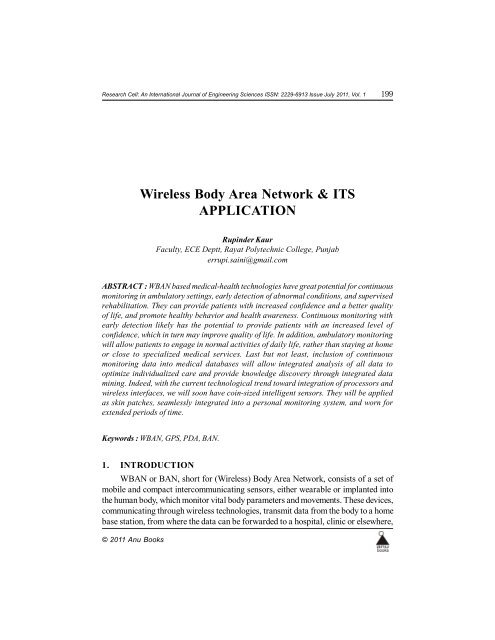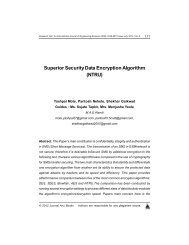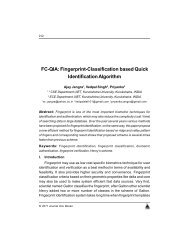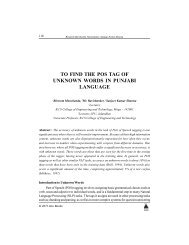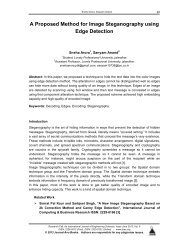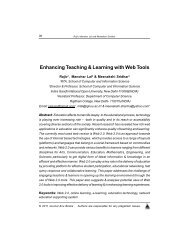Wireless Body Area Network & Its Application - Ijoes.org
Wireless Body Area Network & Its Application - Ijoes.org
Wireless Body Area Network & Its Application - Ijoes.org
You also want an ePaper? Increase the reach of your titles
YUMPU automatically turns print PDFs into web optimized ePapers that Google loves.
Research Cell: An International Journal of Engineering Sciences ISSN: 2229-6913 Issue July 2011, Vol. 1<br />
199<br />
<strong>Wireless</strong> <strong>Body</strong> <strong>Area</strong> <strong>Network</strong> & ITS<br />
APPLICATION<br />
Rupinder Kaur<br />
Faculty, ECE Deptt, Rayat Polytechnic College, Punjab<br />
errupi.saini@gmail.com<br />
ABSTRACT : WBAN based medical-health technologies have great potential for continuous<br />
monitoring in ambulatory settings, early detection of abnormal conditions, and supervised<br />
rehabilitation. They can provide patients with increased confidence and a better quality<br />
of life, and promote healthy behavior and health awareness. Continuous monitoring with<br />
early detection likely has the potential to provide patients with an increased level of<br />
confidence, which in turn may improve quality of life. In addition, ambulatory monitoring<br />
will allow patients to engage in normal activities of daily life, rather than staying at home<br />
or close to specialized medical services. Last but not least, inclusion of continuous<br />
monitoring data into medical databases will allow integrated analysis of all data to<br />
optimize individualized care and provide knowledge discovery through integrated data<br />
mining. Indeed, with the current technological trend toward integration of processors and<br />
wireless interfaces, we will soon have coin-sized intelligent sensors. They will be applied<br />
as skin patches, seamlessly integrated into a personal monitoring system, and worn for<br />
extended periods of time.<br />
Keywords : WBAN, GPS, PDA, BAN.<br />
1. INTRODUCTION<br />
WBAN or BAN, short for (<strong>Wireless</strong>) <strong>Body</strong> <strong>Area</strong> <strong>Network</strong>, consists of a set of<br />
mobile and compact intercommunicating sensors, either wearable or implanted into<br />
the human body, which monitor vital body parameters and movements. These devices,<br />
communicating through wireless technologies, transmit data from the body to a home<br />
base station, from where the data can be forwarded to a hospital, clinic or elsewhere,<br />
© 2011 Anu Books
200<br />
Rupinder Kaur<br />
real-time[1][2]. A <strong>Body</strong> <strong>Area</strong> <strong>Network</strong> is a network containing sensor nodes in<br />
close proximity to a person’s body monitoring vital signals of the human body and a<br />
more intelligent node capable of handle more advanced signal processing.<br />
A <strong>Wireless</strong> <strong>Body</strong> <strong>Area</strong> <strong>Network</strong> (WBAN) connects independent nodes (e.g.<br />
sensors and actuators) that are situated in the clothes, on the body or under the skin<br />
of a person. The network typically expands over the whole human body and the<br />
nodes are connected through a wireless communication channel[3]. A <strong>Wireless</strong> <strong>Body</strong><br />
<strong>Area</strong> <strong>Network</strong> (WBAN) consists of several small devices close to, attached to or<br />
implanted into the human body. These devices communicate by means of a wireless<br />
network. Interaction with the user or other persons is generally handled by a central<br />
device, e.g. a PDA.<br />
Figure1: <strong>Body</strong> area network [4]<br />
Our era is witnessing an increasing pressure on quality and quantity of healthcare<br />
due to the increase of aging population, chronic diseases, and health consciousness<br />
of people. People put more attention in prevention and early risk detection. In US<br />
and European countries, retired parents usually do not live with their children. A<br />
system that can continuously monitor the health condition of elderly people and<br />
share information with remote care providers or hospitals will be in great demand.<br />
As an effort of catching this trend, body area network (BAN) as an emerging<br />
technology for providing this kind of health information, has been attracting more<br />
and more attentions recently. IEEE has launched the IEEE 802.15 Task Group 6<br />
(BAN) in November 2007 to develop a communication standard optimized for low<br />
power devices, and operating on, in or around the human body to serve a variety of<br />
© 2011 Anu Books
Research Cell: An International Journal of Engineering Sciences ISSN: 2229-6913 Issue July 2011, Vol. 1<br />
201<br />
applications including medical and consumer electronics. In more common terms, a<br />
<strong>Body</strong> <strong>Area</strong> <strong>Network</strong> will be a network containing sensor nodes in close proximity to<br />
a person’s body monitoring vital signals of the human body and a more intelligent<br />
node capable of handle more advanced signal processing. Although the most obvious<br />
application of BAN is in the medical sector there are also more recreational uses to<br />
BAN. By this convenient means, elderly people can keep track of their health<br />
conditions without frequent visits to their doctors’ offices. Meanwhile, their doctors<br />
can still access the data and give their patients advices based on these data.[5]<br />
1.1 STANDARD USED IN WBAN:<br />
a) Bluetooth.<br />
b) Zigbee.<br />
c) <strong>Wireless</strong> LAN.<br />
d) Radio frequency transceiver.<br />
e) Cellular phone.<br />
Power consumption must be reduced below 100ìW for radio interface. But<br />
today’s low power radios such as Bluetooth and Zigbee cannot meet this stringent<br />
requirement. The emerging Ultra-Wide Band (UWB) technology shows strong<br />
advantages in reaching this target. First, most of the complexity of an UWB system<br />
is in the receiver, which is a perfect scenario in the WBAN context. Second, the<br />
very little hardware complexity of an UWB transmitter offers the potential for lowcost<br />
and highly integrated solutions. Finally, in a pulse-based UWB scheme, the<br />
transmitter can be duty-cycled at the pulse rate, thereby reducing the baseline power<br />
consumption. We present a low-power UWB transmitter that can be fully integrated<br />
in standard CMOS technology. Measured performances of the pulse generator are<br />
provided, showing the potential of UWB for low power and low cost implementations<br />
[6].<br />
The rest of the paper is <strong>org</strong>anized as follows. Section 2 discusses wireless<br />
body area network. The functional level of WBAN is discussed briefly in Section 3.<br />
Design issue has been discussed in Section 4. <strong>Application</strong>s have been discussed in<br />
Section 5. Finally, we conclude our work in Section 6.<br />
© 2011 Anu Books
202<br />
Rupinder Kaur<br />
2. WBAN<br />
WBAN network consist of two types of nodes i.e. several devices or sensors can<br />
be attached to body by two methods.<br />
a) Implanted node.<br />
b) On-body node (i.e. external).<br />
These nodes are placed in a star or multihop topology. But star topology is preferred.<br />
With the star topology there are two communication methods, which are beacon mode<br />
and non-beacon mode. In beacon mode, communication is controlled by the network<br />
coordinator, which transmits beacons for device synchronization and network association<br />
control. The network coordinator defines the start and end of a super frame by transmitting<br />
a periodic beacon. The length of the beacon period and hence the duty cycle of the<br />
system can be defined by the user between certain limits as specified in the standard.<br />
In non-beacon mode, a network node can send data to the coordinator, by using<br />
CSMA/CA if required. To receive the data from the coordinator the node must power up<br />
and poll the coordinator. The advantage of non-beacon mode is that the node’s receiver<br />
does not have to regularly power-up to receive the beacon. The disadvantage is that the<br />
nodes must wake up to receive the beacon and the coordinator cannot communicate at<br />
anytime with the node but must wait to be invited by the node to communicate.<br />
Figure2: The overall WBAN topology [7].<br />
© 2011 Anu Books
Research Cell: An International Journal of Engineering Sciences ISSN: 2229-6913 Issue July 2011, Vol. 1<br />
203<br />
The overall WBAN topology is shown in Fig. 2. The central node receives<br />
acceleration data from all the remote nodes, and forwards both its own and the<br />
received data to the data acquisition PDA. A Bluetooth connection (F2M01 serialto-Bluetooth<br />
adapter) with up to 100m range is used for this data link. As an<br />
option, a wired RS-232 link can be used.[7].<br />
3. FUNCTIONAL LEVELS OF WBAN<br />
The WBAN system is divided into three levels. The lowest level consists a<br />
set of intelligent sensors or nodes. These are the reduced function devise. These<br />
can only communicate with their parent device and cannot act as parent. The<br />
second level is the personal server (Internet enabled PDA, cell-phone, or home<br />
computer). These are full function devices. And they can communicate with their<br />
children as well as with the external network. The third level encompasses a<br />
network of remote server which is the remote application to which data or<br />
information is transferred.<br />
Continuous technological advances in integrated circuits, wireless<br />
communication, and sensors enable development of miniature, non-invasive<br />
physiological sensors that communicate wirelessly with a personal server<br />
and subsequently through the Internet with a remote emergency, weather<br />
forecast or medical database server; using baseline (medical database), sensor<br />
(WBAN) and environmental (emergency or weather forecast) information,<br />
algorithms may result in patient-specific recommendations. The personal server,<br />
running on a PDA or a 3 G cell phone, provides the human-computer interface<br />
and communicates with the remote server(s). Figure 3 shows a generalized<br />
overview of a multi-tier system architecture; the lowest level encompasses a set<br />
of intelligent physiological sensors; the second level is the personal server (Internet<br />
enabled PDA, cell-phone, or home computer) and the third level encompasses a<br />
network of remote health care servers and related services (Caregiver, Physician,<br />
Clinic, Emergency, Weather). Each level represents a fairly complex subsystem<br />
with a local hierarchy employed to ensure efficiency, portability, security, and<br />
reduced cost illustrates an example of information flow in an integrated WBAN<br />
system.[8][9].<br />
© 2011 Anu Books
204<br />
Rupinder Kaur<br />
3.1 Sensor level<br />
WBAN can include a number of physiological sensors depending on the enduser<br />
application. Information of several sensors can be combined to generate new<br />
information such as total energy expenditure. An extensive set of physiological<br />
sensors may include the following:<br />
• An ECG (electrocardiogram) sensor for monitoring heart activity.<br />
• An EMG (electromyography) sensor for monitoring muscle activity.<br />
• An EEG (electroencephalography) sensor for monitoring brain electrical<br />
activity.<br />
• A blood pressure sensor.<br />
• A tilt sensor for monitoring trunk position.<br />
• A breathing sensor for monitoring respiration.<br />
• Movement sensors used to estimate user’s activity.<br />
Figure3: <strong>Wireless</strong> <strong>Body</strong> <strong>Area</strong> <strong>Network</strong> of Intelligent Sensors for Patient Monitoring [8]<br />
© 2011 Anu Books
Research Cell: An International Journal of Engineering Sciences ISSN: 2229-6913 Issue July 2011, Vol. 1<br />
205<br />
Figure4: Data flow in an integrated WBAN [9]<br />
• A “smart sock” sensor or a sensor equipped shoe insole used to delineate<br />
phases of individual steps.<br />
These physiological sensors typically generate analog signals that are<br />
interfaced to standard wireless network platforms that provide computational,<br />
storage, and communication capabilities.<br />
3.2 Personal server level<br />
The personal server performs the following tasks:<br />
• Initialization, configuration, and synchronization of WBAN nodes.<br />
• Control and monitor operation of WBAN nodes.<br />
• Collection of sensor readings from physiological sensors.<br />
• Processing and integration of data from various physiological sensors<br />
providing better insight into the user state.<br />
• Providing an audio and graphical user-interface that can be used to<br />
relay early warnings or guidance (e.g., during rehabilitation).<br />
• Secure communication with remote healthcare provider servers in the<br />
upper level using Internet services.<br />
The personal server can be implemented on an off-the-shelf Internet-enabled<br />
PDA (Personal Digital Assistant) or 3 G cell phone, or on a home personal computer.<br />
Multiple configurations are possible depending on the type of wireless network<br />
© 2011 Anu Books
206<br />
Rupinder Kaur<br />
employed. For example, the personal server can communicate with individual<br />
WBAN nodes using the Zigbee wireless protocol that provides low-power network<br />
operation and supports virtually an unlimited number of network nodes. A network<br />
coordinator, attached to the personal server, can perform some of the preprocessing<br />
and synchronization tasks. Other communication scenarios are also<br />
possible. For example, the personal server running on a Bluetooth or WLAN<br />
enabled PDA can communicate with remote upper-level services through a home<br />
computer; the computer then serves as a gateway.[8][9].<br />
3.3 Medical service level<br />
• An emergency service: If the received data are out of range or indicate<br />
an imminent medical condition.<br />
• The exact location of the patient: If the personal server is equipped<br />
with GPS sensor.<br />
• Monitoring the activity of the patient: By medical professionals.<br />
We developed several type wearable physiological signal devices as shown<br />
in figure 5.Our strategy is that every possible physiological signal instruments is<br />
built into a physiological signal device and a central processor supervise the operation<br />
of each component, analyzes the measured data and then rapidly transfer these<br />
data using WBAN such as ZigBee.[10].<br />
wrist watch type<br />
chest belt type<br />
© 2011 Anu Books
Research Cell: An International Journal of Engineering Sciences ISSN: 2229-6913 Issue July 2011, Vol. 1<br />
207<br />
4. DESIGN ISSUES<br />
shoulder type necklace type<br />
Figure5: wearable physiological signal devices [10].<br />
There are certain issues which have to be considered while designing a WBAN<br />
system.<br />
4.1 Types of nodes:<br />
The nodes can be motion & position sensors such as accelerometers, health<br />
monitoring sensors such as ECG, EMG, hearing of visual aid and environment sensors<br />
such as oxygen, pressure or humidity sensors. Accelerometers and gyroscopes offer<br />
greater sensitivity and are more applicable for monitoring of motion since they generate<br />
continuous output.<br />
Figure 6: ECG & Motion Sensor [9].<br />
© 2011 Anu Books
208<br />
Rupinder Kaur<br />
Sampling rate for the sensor node:<br />
It is found that the human induced activity has frequency between 0 to 18 or<br />
30 Hz. So the sample rate of 10 to 100 Hz is considered to be sufficient without<br />
loosing any information.<br />
4.2 Power source:<br />
Sensors have to be extremely power efficient, because most of the WBAN<br />
sensors are battery operated and are required to last long without any need of<br />
maintenance. The other thing is that the WBAN consists of fairly large number of<br />
devices so frequent battery changes for multiple WBAN sensors would likely<br />
hamper user’s acceptance and increase the cost. In addition, if we think about<br />
implantable sensors, low power consumption is very important. These kinds of<br />
sensors would ideally be self-powered, using energy extracted from the<br />
environment.<br />
4.3 Size and weight of sensors:<br />
To be unobtrusive, the sensors must be lightweight with small form factor.<br />
The size and weight of sensors is predominantly determined by the size and weight<br />
of batteries. Requirements for extended battery life directly oppose the requirement<br />
for small form factor and low weight.<br />
4.4 Sensor Node Identification & Association:<br />
The node is identified by the device ID which is unique for each device, but<br />
still there are some issues related to identifying the device related to a specific<br />
task. Such that if we have two motion sensors, one to monitor hand movement<br />
and the other to monitor foot 3 3 movement. Then how the server will know which<br />
one is mounted on the foot and which one is at hand? There are several ways to<br />
cope with this problem. One is that we manually enter the device ID of the sensor<br />
mounted at hand for the task of hand movement monitoring or we can use a<br />
systematic procedure for device recognition which is explained as follows. The<br />
user is given a list of instructions which ask the user to stimulate the sensors at a<br />
pre-defined pattern. And by monitoring the activity level of every sensor, the server<br />
will know which device is activated for what instruction and will assign it to the<br />
respective task.[9].<br />
© 2011 Anu Books
Research Cell: An International Journal of Engineering Sciences ISSN: 2229-6913 Issue July 2011, Vol. 1<br />
209<br />
4.5 Sensor Node Calibration:<br />
There are two type of calibrations for the sensor nodes. One is sensor<br />
calibration which is to accommodate sensor-to-sensor variations. When a sensor<br />
is replaces or newly added to the network, it must be calibrated according to the<br />
requirement. This type of calibration is needed only one time but it is necessary<br />
for sensor preparation. Exact nature of the calibration is sensor dependent. The<br />
other type is session calibration which is required immediately prior starting a new<br />
monitoring session to calibrate the sensor in the context of its current environment.<br />
This is also sensor dependent. Some sensor may need it and some may not.<br />
4.6 Sensor location and mounting:<br />
Although the purpose of the measurement does influence sensor location,<br />
researchers seem to disagree on the ideal body location for sensors. e.g. A motion<br />
sensor attached to an ankle is the most discriminative single position for state<br />
recognition, now they are using position recognition sensors at back (waist line), in<br />
thigh pocket, wrist and are able to accurately monitor a subject’s activity and with<br />
the assistance of gyroscopes and compass they are able to successfully estimate<br />
a subject’s change in location. Sensor attachment is also a critical factor, since the<br />
movement of loosely attached sensors creates spurious oscillations after an abrupt<br />
movement that can generate false events or mask real events.<br />
4.7 Seamless system configuration:<br />
The intelligent WBAN sensors should allow users to easily assemble a robust<br />
ad-hoc WBAN, depending on the user’s state of health. The user should be able<br />
to use “off-the-shelf” sensors, manufactured by different companies, and sold<br />
“over-the-counter”. Each sensor should be able to identify itself and declare its<br />
operational range and functionality. In addition, they should support easy<br />
customization for a given application.[11].<br />
4.8 Intuitive and simple user interface:<br />
The end users are not technicians or scientist or the user may be a handicap<br />
where the BAN is used as rehabilitation purposes. So the interface should be<br />
simple enough for the users to easily understand and handle properly.<br />
© 2011 Anu Books
210<br />
Rupinder Kaur<br />
4.9 Interference:<br />
Almost all of the short range networks operate in the ISM range of frequency.<br />
Such as wireless LANs and Bluetooth. IEEE 802.11b/g wireless Ethernet operate<br />
in 2.4 GHz band and most of the microwave ovens operate at 2.45 GHz. So there is<br />
a big problem in the form of interference and we have to deal with it to implement an<br />
operational and secure WBAN. There can be interference between WBAN of one<br />
person and the other’s if they are close enough. A WBAN can be configured to<br />
listen to only those devices which are part of the network by using device<br />
authentication. Biomedical signals which are unique for every person can be used<br />
for device authentication.[12][13].<br />
5. APPLICATIONS<br />
Initial applications of WBANs are expected to appear primarily in the healthcare<br />
domain, especially for continuous monitoring and logging vital parameters of patients<br />
suffering from chronic diseases such as diabetes, asthma and heart attacks. A WBAN<br />
network in place on a patient can alert the hospital, even before he has a heart<br />
attack, through measuring changes in his vital signs. A WBAN network on a diabetic<br />
patient could auto inject insulin though a pump, as soon as his insulin level declines,<br />
thus making the patient ‘doctor-free’ and virtually healthy.[16].<br />
• Diabetes.<br />
–Glucose monitoring and insulin release.<br />
• Implanted ECG monitoring and arrhythmia alarming system.<br />
• Hypertension.<br />
–Continuous in vivo bloody pressure monitoring and regulation system.<br />
• Spinal cord injuries.<br />
–Bladder pressure sensor.<br />
–Micro stimulator.<br />
• Animal experiment for new drug design.[17].<br />
Other applications of this technology include sports, military, or security.<br />
Extending the technology to new areas could also assist communication by seamless<br />
exchanges of information between individuals, or between individual and machines.<br />
Imagine businesspeople exchanging business cards, just with a handshake, with the<br />
help of BAN sensors. These applications might become reality with the WBAN<br />
implementation very soon.<br />
© 2011 Anu Books
Research Cell: An International Journal of Engineering Sciences ISSN: 2229-6913 Issue July 2011, Vol. 1<br />
211<br />
A WBAN offers many promising new applications in the area of remote health<br />
monitoring, home/health care, medicine, multimedia, sports and many other, all of<br />
which make advantage of the unconstrained freedom of movement a WBAN offers.<br />
In the medical field, for example, a patient can be equipped with a wireless body<br />
area network consisting of sensors that constantly measure specific biological<br />
functions, such as temperature, blood pressure, heart rate, electrocardiogram (ECG),<br />
respiration, etc. The advantage is that the patient doesn’t have to stay in bed, but<br />
can move freely across the room and even leave the hospital for a while. This<br />
improves the quality of life for the patient and reduces hospital costs. In addition,<br />
data collected over a longer period and in the natural environment of the patient,<br />
offers more useful information, allowing for a more accurate and sometimes even<br />
faster diagnosis.<br />
The WBAN technology can be used for computer-assisted physical rehabilitation<br />
in ambulatory settings and monitoring of trends during recovery. An integrated system<br />
can synergize the information from multiple sensors, warn the user in the case of<br />
emergencies, and provide feedback during supervised recovery or normal activity.<br />
Candidate applications include post-stroke rehabilitation, orthopaedic rehabilitation<br />
(e.g. hip/knee replacement rehabilitation), and supervised recovery of cardiac patients.<br />
In the case of orthopaedic rehabilitation the system can measure forces and<br />
accelerations at different points and provide feedback to the user in real-time.<br />
Unobtrusive monitoring of cardiac patients can be used to estimate intensity of<br />
activities in user’s daily routine and correlate it with the heart activity.<br />
In addition, WBAN systems can be used for gait phase detection during<br />
programmable, functional electrical stimulation, analysis of balance and monitoring<br />
of Parkinson’s disease patients in the ambulatory setting, computer supervision of<br />
health and activity status of elderly, weight loss therapy, obesity prevention, or in<br />
general promotion of a healthy, physically act.[5][17].<br />
5.1 MEDICAL APPLICATIONS OF WBAN<br />
Medical applications of WBAN cover continuous waveform sampling of<br />
biomedical signals, monitoring of vital signal information, and low rate remote control<br />
of medical devices . They can be broadly classified into two categories depending<br />
on their operating environments. One is the so-called wearable BAN, which is mainly<br />
operated on the surface or in the vicinity of body, such as medical monitoring. Another<br />
is the so-called implantable BAN, which is operated inside the human body, e.g.<br />
capsule endoscope and pacemaker.<br />
© 2011 Anu Books
212<br />
Rupinder Kaur<br />
A) NETWORK ARCHITECHTURE OF MEDICAL WBAN<br />
In this study, the architecture under consideration is shown in Figure 7. This<br />
architecture consists of two main parts: multiple body sensor units and a body central<br />
unit. The body sensor units<br />
Figure 7: BAN architecture under consideration [6] [19].<br />
perform vital medical data acquisition, data (pre-) processing, actuator control,<br />
data transmission and provide some basic user feedback. The body central unit links<br />
multiple sensor units, performs data collection, data processing/compression, actuator<br />
control, basic event detection/management and provides external access together<br />
with a personalized user interface. In our study, we will use the ECG signal as an<br />
example to evaluate its performance in healthcare environment. [18].<br />
B) A PROTOTYPE WBAN SYSTEM WITH BLUETOOTH<br />
From a general understanding of the BAN and the system requirements, it is<br />
evident that possible candidates in implementing BAN should be short range<br />
communication technologies. IEEE 802.15.1 Bluetooth operates in the 2.4GHz ISM<br />
band, from 2400MHz to 2483.5MHz .The system employs a frequency-hopping<br />
multiple access schemes to combat interference and fading. The symbol rate is 1<br />
Msymbol/s supporting a bit rate of 1 Mb/s. For example, ECG signal from each<br />
© 2011 Anu Books
Research Cell: An International Journal of Engineering Sciences ISSN: 2229-6913 Issue July 2011, Vol. 1<br />
213<br />
channel are digitized at 360 Hz with 11-bit resolution implying a data rate of 3.84<br />
Kbps per channel, so all 12 channels of ECG data can potentially be transmitted<br />
using Bluetooth. In addition, forward error correction (FEC) and automatic repeat<br />
request (ARQ) for retransmission are used as authentication of reception to ensure<br />
reliable communication. Based on its suitability of BAN, we test a prototype system<br />
for BAN using Bluetooth technology. We will discuss the detailed system in the<br />
following.[19].<br />
C) System block diagram of WBAN<br />
The whole system block diagram is in Figure 8. First, the digitized ECG signals<br />
are passed through the data compression module in order to reduce the transmission<br />
requirement and the needed storage capacity.<br />
Figure 8: System block diagram [19].<br />
Then the compressed data are transmitted through the Bluetooth Radio System<br />
module. The details of these modules are described in the following sections. At the<br />
receiver, the inverse processes are performed to reconstruct the original signals<br />
ECG data compression:<br />
By utilizing the ECG compression techniques, we expect to achieve the objective<br />
of reducing the amount of digitized ECG data as much as possible while preserving<br />
the diagnostic information in the reconstructed signal. The compression ratio (CR)<br />
is a measure of the compression performance, defined as the ratio between the<br />
number of bits needed to represent the original and the compressed signals. For the<br />
error criterion, the percentage root-mean-square difference (PRD) measure is<br />
employed. However, the clinical acceptability of the reconstructed signal should<br />
always be determined through visual inspection by physicians. Existing data<br />
© 2011 Anu Books
214<br />
Rupinder Kaur<br />
compression techniques for ECG signals can be classified into three main categories:<br />
Direct data compression methods, transformation methods and parameter extraction<br />
methods. Based on the ECG data characteristics and implementation complexity,<br />
we choose the following schemes:<br />
1. Split the original signal into M successive blocks, each having N samples.<br />
2. Transform each block using discrete cosine transform (DCT).<br />
3. Quantize of DCT coefficients.<br />
4. Encode the quantized DCT coefficients using LZW coding.<br />
Bluetooth radio system:<br />
Modulation:<br />
The modulation is Gaussian frequency shift keying (GFSK) with a bandwidthbit<br />
period product, also known as bandwidth (BT), of 0.5. The modulation index may<br />
vary between 0.28 and 0.35.<br />
Demodulation:<br />
At the receiver, we use a simple differential demodulator. The complex baseband<br />
signal was sampled and multiplied by its complex conjugate that was delayed<br />
by a symbol period. The resulting differential phases of the symbols, n n”1 Ö “Ö are<br />
detected and decided that ‘1’ was sent if n n”1 Ö “ Ö was greater than or equal to<br />
zero and ‘0’ was sent if n n”1 Ö “Ö was negative.[19][20].<br />
6. CONCLUSION<br />
WBAN based m-Health technologies have great potential for continuous<br />
monitoring in ambulatory settings, early detection of abnormal conditions, and<br />
supervised rehabilitation. They can provide patients with increased confidence and<br />
a better quality of life, and promote healthy behaviour and health awareness.<br />
Continuous monitoring with early detection likely has the potential to provide patients<br />
with an increased level of confidence, which in turn may improve quality of life. In<br />
addition, ambulatory monitoring will allow patients to engage in normal activities of<br />
daily life, rather than staying at home or close to specialized medical services. Last<br />
but not least, inclusion of continuous monitoring data into medical databases will<br />
allow integrated analysis of all data to optimize individualized care and provide<br />
knowledge discovery through integrated data mining. Indeed, with the current<br />
technological trend toward integration of processors and wireless interfaces, we<br />
© 2011 Anu Books
Research Cell: An International Journal of Engineering Sciences ISSN: 2229-6913 Issue July 2011, Vol. 1<br />
215<br />
will soon have coin-sized intelligent sensors. They will be applied as skin patches,<br />
seamlessly integrated into a personal monitoring system, and worn for extended<br />
periods of time.<br />
Automatic integration of information from m-Health systems into research<br />
databases can provide medical community possibility of data mining of huge amounts<br />
of data. This will allow improved insights into disease evolution, the rehabilitation<br />
process, and the effects of drug therapy.<br />
7. REFERENCES<br />
[1] O’Donoghue, J. Herbert, J. and Fensli, R., “Sensor Validation within a Pervasive<br />
Medical Environment”, In Proceedings of IEEE Sensors, South Korea, ISBN<br />
1-4244-0376-6, (2006).<br />
[2] O’Donoghue, J., Herbert, J. and Kennedy, R., “Data Consistency within a<br />
Pervasive Medical Environment”, In Proceedings of IEEE Sensors, South<br />
Korea, ISBN 1-4244-0376-6, (2006).<br />
[3] www.wica.intec.ugent.be.<br />
[4] Singularityhub.com.<br />
[5] Katrin Bilstrup, “A Preliminary Study of <strong>Wireless</strong> <strong>Body</strong> <strong>Area</strong> <strong>Network</strong>s”,<br />
Halmstad University, Box 823, SE-30118 Halmstad, Sweden,(August 2008).<br />
[6] Julien Ryckaert1, Claude Desset, Vincent de Heyn, Mustafa Badaroglu, Piet<br />
Wambacq2, Geert Van der Plas, Bart Van Poucke “Ultra-WideBand Transmitter<br />
for <strong>Wireless</strong> <strong>Body</strong> <strong>Area</strong> <strong>Network</strong>s”,(2005).<br />
[7] Arto Ylisaukko-oja, Elena Vildjiounaite, Jani Mäntyjärvi,”Five-Point Acceleration<br />
Sensing <strong>Wireless</strong> <strong>Body</strong> <strong>Area</strong> <strong>Network</strong> - Design and Practical Experiences”,<br />
VTT Electronics Kaitoväylä 190571 Oulu, Finland(2004).<br />
[8] Emil Jovanov, Aleksandar Milenkovic, Chris Otto Piet C de Groen, “A wireless<br />
body area network of intelligent motion sensors for computer assisted physical<br />
rehabilitation”, Journal of NeuroEngineering and Rehabilitation, University of<br />
Alabama in Huntsville, vol:2,pp.2-6(March 2005).<br />
[9] Ahmed Faheem, “ <strong>Wireless</strong> <strong>Body</strong> <strong>Area</strong> Sensor <strong>Network</strong>”,<br />
faheem.ahmed@uwasa.fi ID: P87359, (dec,12.2006).<br />
© 2011 Anu Books
216<br />
Rupinder Kaur<br />
[10] Joonyoung Jung1 , Kiryong Ha1, Jeonwoo Lee1 Youngsung Kim2 and Daeyoung<br />
Kim3"<strong>Wireless</strong> <strong>Body</strong> <strong>Area</strong> <strong>Network</strong> in a Ubiquitous Healthcare System for<br />
PhysiologicalSignal Monitoring and Health Consulting”,1 Electronics and<br />
Telecommunications Research Institute, 161 Gajeong-dong, Yuseong-gu,<br />
Deajeon, 305-700, Republic of Korea, pp. 47-54(2008).<br />
[11] Steve Warren1, Jeffrey Lebak1, Jianchu Yao3, Jonathan Creekmore2,<br />
Aleksandar Milenkovic2, and Emil Jovanov2, “Interoperability and Security in<br />
<strong>Wireless</strong> <strong>Body</strong> <strong>Area</strong> <strong>Network</strong> Infrastructures”, (September 1-4, 2005).<br />
[12] Marina Sukor, Sharifah Ariffin and Norsheila Fisal and S.K. Syed Yusof, Adel<br />
Abdallah, “Performance study of wireless body area network in medical<br />
environment”, Department of Telematic and Optic, Faculty of Electrical<br />
Engineering, Universiti Teknologi Malaysia, UTM Skudai, 81310, Malaysia,<br />
pp202-206,(2008).<br />
[13] Andrew (Jian) Zhang_, Leif W. Hanlen, Dino Miniutti_, David Rodda, Ben<br />
Gilbert, “Interference in <strong>Body</strong> <strong>Area</strong> <strong>Network</strong>s:Are signal-links and interferencelinks<br />
independent?”, NICTA Canberra, Australia.<br />
[14] M.J. Morón, J.R. Luque, E.J. Cuberos, A.A. Botella, E. Casilari, A. Díaz Estrella<br />
, “J2ME and Smart Phones as Platform for a Bluetooth <strong>Body</strong> <strong>Area</strong> <strong>Network</strong><br />
for Patient-Telemonitoring”,29 th IEEE EMBS Annual international conference<br />
,University of malaga, spain,Lyon (France),(24th August 2007).<br />
[15] Poon, C C Y | Zhang, Yuan-Ting | Bao, Shu-Di, “A novel biometrics method to<br />
secure wireless body area sensor networks for telemedicine and m-health”,IEEE<br />
Communications Magazine. Vol. 44, no. 4, pp. 73-81(Apr. 2006).<br />
[16] O’Donovan, T., O’Donoghue, J., Sreenan, C., O’Reilly, P., Sammon, D. and<br />
O’Connor, K., “A Context Aware <strong>Wireless</strong> <strong>Body</strong> <strong>Area</strong> <strong>Network</strong> (BAN)”, In<br />
proceedings of the Pervasive Health Conference, (2009).<br />
[18] Mehmet Rasit Yuce, Member, IEEE, Ho Chee Keong, and Moo Sung Chae, “<br />
Wideband Communication for Implantable and Wearable Systems”, IEEE<br />
transactions on microwave theory and techniques, vol. 57,pp. 2597-2604(10<br />
oct, 2009).<br />
[19] Bo Yu, Prof. Liuqing Yang, Ph.D., “<strong>Wireless</strong> <strong>Body</strong> <strong>Area</strong> <strong>Network</strong>s for<br />
Healthcare: A Feasibility Study”,(2009).<br />
[20] Occam’s Razor,”Bluetooth vs ZigBee”, (October 23, 2004).<br />
© 2011 Anu Books


